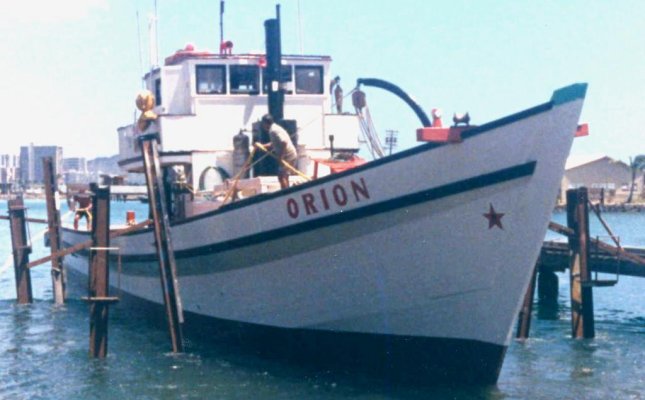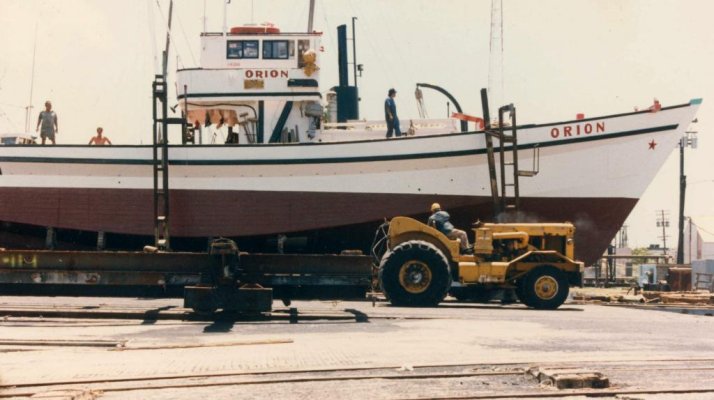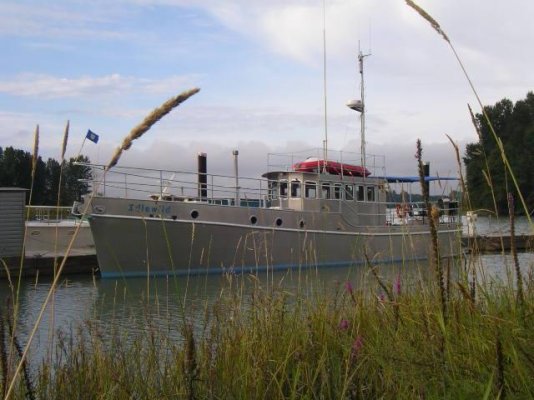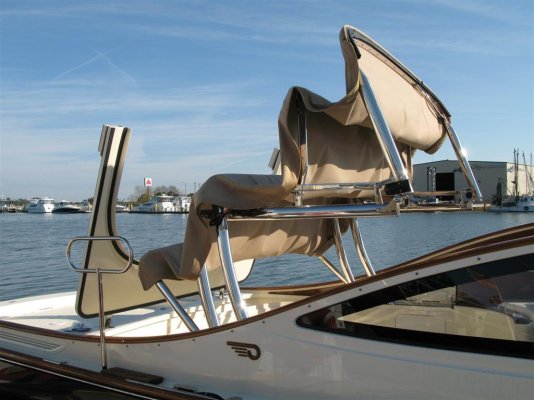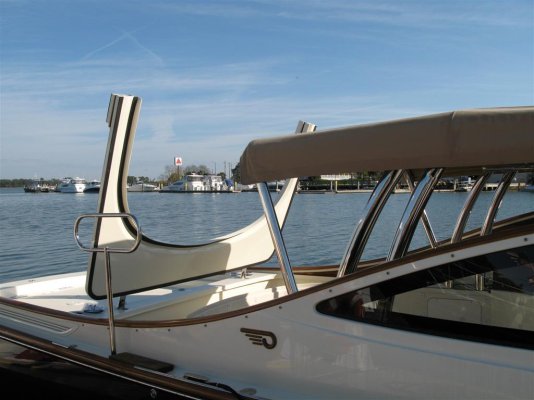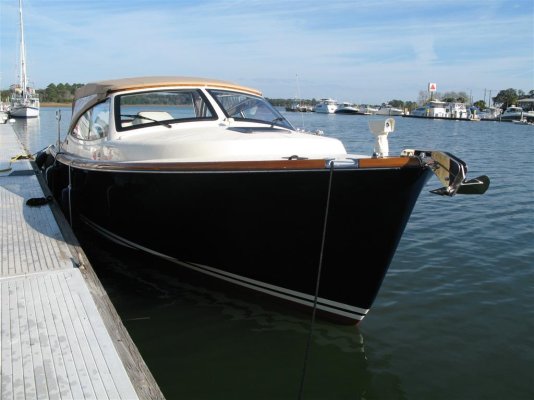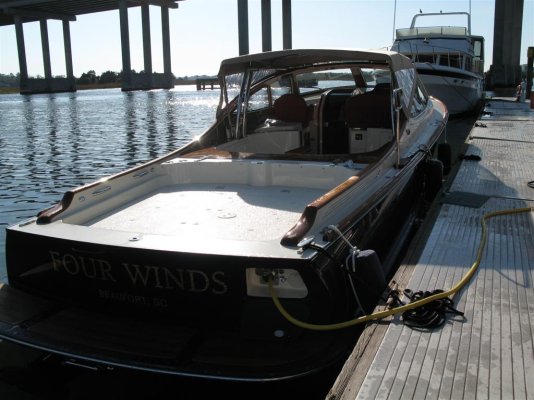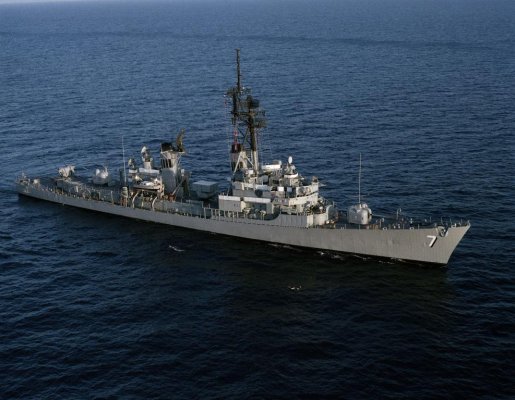To get away from the "what defines planing, semi-planing, semi-displacement, displacement, sinking, sunk, sank" discussion for a bit, I thought I'd post a couple of photos of my all-time favorite boat design.*
These boats comprised the tuna fleet in Honlulu from the 1940s when they were built until the 1980s when (a) they wore out and (b) the tuna industry shifted to a whole different way of fishing.* Locally known as sampans or aku boats (aku is the Hawaiian word for albacore tuna), they were day boats.* They'd go into Pearl Harbor in the morning, net live bait in the lochs, then head out into*the open ocean*in search of feeding tuna schools.* When they found one, they would drive the boat right into the middle of it and one or two guys would start shoveling live bait over the side as fast as they could while the boat moved slowly forward,* The baitfish would scoot under the boat to get away from the frenzied tuna, but since the boat was moving forward they'd all end up at the stern.*
About five or six guys would stand on a board across the stern barefoot with their toes braced against a bit of molding screwed to the outside of the board.* Each one had a short bamboo pole with a length of line and huge chromed, barbless hook on the end.* They'd toss this hook into the middle of the feeding frezy of tuna, a fish would bite, and they'd lever the fish out of the water over their heads into the fish hold where a guy woud unhook the fish and yell, and the fisherman would lever the hook back over his head into the water.* All this time the boat is working through eight, ten, twelve*foot swells with wind waves on top of them.* The boat would be surrounded by screaming seabirds (not gulls, there are no gulls in Hawaii),*tuna would be foaming the water, and the air would be filled with fish flying forward into the boat and bare hooks flying back.* It was an absolutely amazing sight.
At the end of the day they would run back to Kewalo Basin in Honolulu and unload their catch at the tuna cannery.* Then they'd do it all again the next day.
The boats were designed and built in Hawaii, and in the 60s there were probably at least a hundred of them, all to this same basic design.* Wood, about 70 feet long, quite narrow.* I believe the word "sampan" is the Japanese word for carvel construction--- smooth-sided as opposed to lapstrake.* They were* beautiful to watch underway in the rough waters around Hawaii.* They would pass us sometimes when we were out fishing in the Molokai Strait.* They were like destroyers, cutting through the waves.* Most of them were powered with a single 6-71.* They were almost all crewed by Japanese-Americans.* At the back of the wheelhouse in every boat was a small shrine to Buddha.
Their hulls were shaped to cut the water, but also minimize rolling.* There are a few-- two or three-- left today, but the ones I saw several years ago were amost derelict.* It never dawned on me all the*years I lived there to take photos of them despite the fact I saw them almost every day.* These photos were sent to me by someone in Hawaii.* In their heyday, they were kept in beautiful condition by their crews.
If money was no object, I'd love to have one of these things, or have one built.* They remain my most favorite boat design, both in terms of aesthetics and in capabilities.
So that's my all-time favorite boat design.* What's yours?* (Not counting your own boat.)
These boats comprised the tuna fleet in Honlulu from the 1940s when they were built until the 1980s when (a) they wore out and (b) the tuna industry shifted to a whole different way of fishing.* Locally known as sampans or aku boats (aku is the Hawaiian word for albacore tuna), they were day boats.* They'd go into Pearl Harbor in the morning, net live bait in the lochs, then head out into*the open ocean*in search of feeding tuna schools.* When they found one, they would drive the boat right into the middle of it and one or two guys would start shoveling live bait over the side as fast as they could while the boat moved slowly forward,* The baitfish would scoot under the boat to get away from the frenzied tuna, but since the boat was moving forward they'd all end up at the stern.*
About five or six guys would stand on a board across the stern barefoot with their toes braced against a bit of molding screwed to the outside of the board.* Each one had a short bamboo pole with a length of line and huge chromed, barbless hook on the end.* They'd toss this hook into the middle of the feeding frezy of tuna, a fish would bite, and they'd lever the fish out of the water over their heads into the fish hold where a guy woud unhook the fish and yell, and the fisherman would lever the hook back over his head into the water.* All this time the boat is working through eight, ten, twelve*foot swells with wind waves on top of them.* The boat would be surrounded by screaming seabirds (not gulls, there are no gulls in Hawaii),*tuna would be foaming the water, and the air would be filled with fish flying forward into the boat and bare hooks flying back.* It was an absolutely amazing sight.
At the end of the day they would run back to Kewalo Basin in Honolulu and unload their catch at the tuna cannery.* Then they'd do it all again the next day.
The boats were designed and built in Hawaii, and in the 60s there were probably at least a hundred of them, all to this same basic design.* Wood, about 70 feet long, quite narrow.* I believe the word "sampan" is the Japanese word for carvel construction--- smooth-sided as opposed to lapstrake.* They were* beautiful to watch underway in the rough waters around Hawaii.* They would pass us sometimes when we were out fishing in the Molokai Strait.* They were like destroyers, cutting through the waves.* Most of them were powered with a single 6-71.* They were almost all crewed by Japanese-Americans.* At the back of the wheelhouse in every boat was a small shrine to Buddha.
Their hulls were shaped to cut the water, but also minimize rolling.* There are a few-- two or three-- left today, but the ones I saw several years ago were amost derelict.* It never dawned on me all the*years I lived there to take photos of them despite the fact I saw them almost every day.* These photos were sent to me by someone in Hawaii.* In their heyday, they were kept in beautiful condition by their crews.
If money was no object, I'd love to have one of these things, or have one built.* They remain my most favorite boat design, both in terms of aesthetics and in capabilities.
So that's my all-time favorite boat design.* What's yours?* (Not counting your own boat.)

